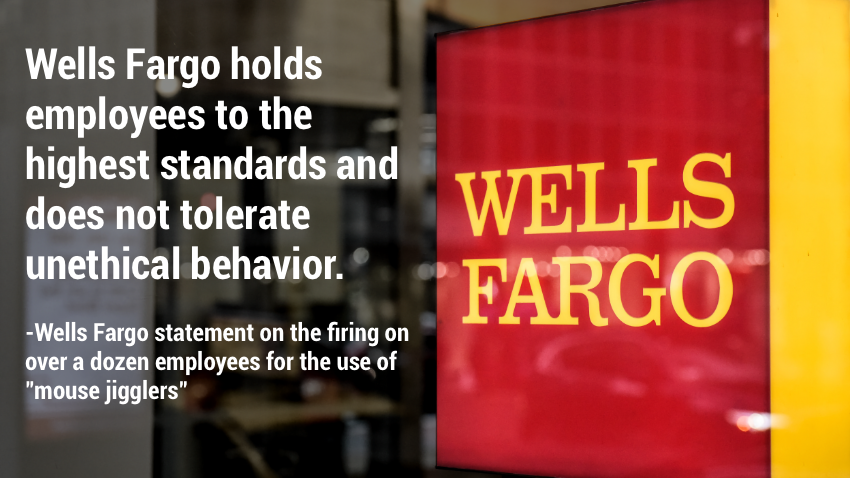Last week, news broke that Wells Fargo fired a group of wealth management employees for using “mouse jigglers” to simulate their presence at their computers. From Bloomberg’s reporting on the news:
Wells Fargo & Co. fired more than a dozen employees last month after investigating claims that they were faking work.
The staffers, all in the firm’s wealth and investment-management unit, were “discharged after review of allegations involving simulation of keyboard activity creating impression of active work,” according to disclosures filed with the Financial Industry Regulatory Authority.
“Wells Fargo holds employees to the highest standards and does not tolerate unethical behavior,” a company spokesperson said in a statement.
Devices and software to imitate employee activity, sometimes known as “mouse movers” or “mouse jigglers,” took off during the pandemic-spurred work-from-home era, with people swapping tips for using them on social-media sites Reddit and TikTok. Such gadgets are available on Amazon.com for less than $20.
Wells having an institutional short fuse for policy violation is understandable. In 2016, it was revealed the bank was systematically opening fake accounts for customers they did not request, over 1.5 million accounts over 5 years. The discovery eventually led to over $8B in fines and lawsuit settlements, as well as other regulatory penalties.
The crux of that scandal was blamed on a strategy of cross-selling new accounts to existing customers. Immense pressure was then placed on front-line employees, with sales quotas that were widely aggressive and even impossible to achieve. The pressure manifested in over 5,300 firings on employees, often with negative comments on the dismissed employees Finra U5s.
This obviously had a major impact on the bank and its reputation with regulators, customers, employees, and shareholders.
Especially one shareholder in particular.
In this clip from Berkshire Hathaway’s 2017 Annual Meeting, Warren Buffet and Charlie Munger discuss their decision to divest of Wells Fargo after more than 31 years of significant ownership:
In his remarks, Buffet draws a connection to the Salomon Brothers. In 1991, Buffett had to step in as Chairman of the $6B Wall Street securities firm during a mishandled scandal at its Treasury desk. Failure by the firm’s leadership to address willful illegal trading practices (details here) led to the New York Fed banning Salomon from participating in Treasury auctions for both its own book and customer accounts. This was effectively a death sentence for the firm, which was only avoided by a personal appeal by Buffet to the NY Fed Chair, and a very real threat to walk away from the company and the inevitable chaos resulting from its collapse.
The whole issue was exacerbated by Salomon’s leadership, including Salomon’s Chairman and CEO, John Gutfreund, who knew about the problem but did nothing.
So, back to the mouse jigglers. Did they learn the right lesson? The prompt punishment of policy violations?
Matt Levin, in equal eloquence and sarcasm, captures the issue thus:
Imagine deciding how to measure and manage the productivity and value added of your wealth and investment management employees while they are working from home. What might you measure?
These people manage portfolios. You could measure their investment return, or return against a benchmark, or their alpha after adjusting for various market, sector and style factors. You could measure how many assets they attract and retain, or how much they generate in fees.
These people deal with clients. You could measure how many clients they bring in, or how many client assets. You could survey the clients and grade the employees based on customer satisfaction. You could even, crudely, have some metric like “call three clients every day,” and make sure they do that.
These people sit at computers. You could monitor their computers to make sure that they’re moving the mouse at least once every five minutes for eight hours a day.
Which of those do you think is the best proxy for, like, contributions to Wells Fargo’s return on equity? Which is the simplest to measure? Which is the simplest to game?
Goodhart’s law - When a measure becomes a target, it ceases to be a good measure
Aligning your ultimate goals with the behaviors that will reasonably get you there and then rallying the organization around those ideas is the fundamental job of leadership. It is not easy. It often requires way more communication and repetition than you think would ever be required. But shortcuts or lazy efforts at this step can, as we’ve seen, lead to catastrophic consequences.
I don’t have any special insight into exactly what was going on in this instance, and it could very well be that this was all very prudent and thoughtful from start to finish. But use this as an opportunity to gauge our own leadership and management systems.
- What incentives are explicitly or implicitly driving your organization’s behavior?
- How well are they aligned with the ultimate outcome you want?
- How do you handle deviations or performance issues?
- Are “rules” or systems ever reviewed and evaluated for the results they are achieving for your business?
And that it for this Friday. More of nature’s derpiest mammal. Click below to let us know how we did:

